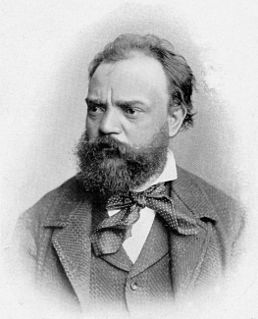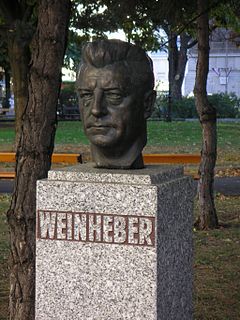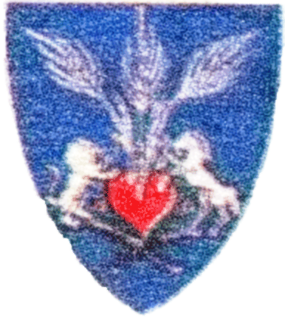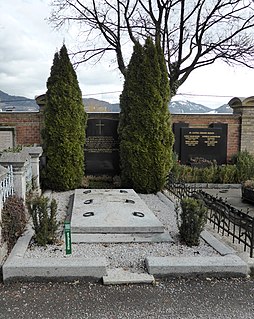Related Research Articles

Antonín Leopold Dvořák was a Czech composer, one of the first to achieve worldwide recognition. Following the Romantic-era nationalist example of his predecessor Bedřich Smetana, Dvořák frequently employed rhythms and other aspects of the folk music of Moravia and his native Bohemia. Dvořák's own style has been described as "the fullest recreation of a national idiom with that of the symphonic tradition, absorbing folk influences and finding effective ways of using them".

Johann Strauss I was an Austrian Romantic composer. He was famous for his waltzes, and he popularized them alongside Joseph Lanner, thereby setting the foundations for his sons to carry on his musical dynasty. He is best known for his composition of the Radetzky March.

Ludwig Anzengruber was an Austrian dramatist, novelist and poet. He was born and died in Vienna, Austria.

Josef Strzygowski was a Polish-Austrian art historian known for his theories promoting influences from the art of the Near East on European art, for example that of Early Christian Armenian architecture on the early Medieval architecture of Europe, outlined in his book, Die Baukunst der Armenier und Europa. He is considered a member of the Vienna School of Art History.

Max Dvořák was a Czech-born Austrian art historian. He was a professor of art history at the University of Vienna and a famous member of the Vienna School of Art History, employing a Geistesgeschichte methodology.
Otto Benesch was an Austrian art historian. He was taught by Max Dvořák and is considered a member of the Vienna School of Art History. He is well known for his catalogue of Rembrandt's drawings. In 1942 he was awarded the Guggenheim Fellowship.
Wilhelm Jerusalem was an Austrian Jewish philosopher and pedagogue.

Franz Serafin Exner was an Austrian physicist.
The Vienna School of Art History was the development of fundamental art-historical methods at the University of Vienna. This school was not actually a dogmatically unified group, but rather an intellectual evolution extending over a number of generations, in which a series of outstanding scholars each built upon the achievements of their forerunners, while contributing their own unique perspectives. Essential elements of this evolution became fundamental for modern art history, even if the individual methods can today no longer claim absolute validity.

Joseph (Josef) Samuel Bloch was an Austrian rabbi and deputy of Polish descent.

Translated from German Wikipedia

Josef Kriehuber was an Austrian lithographer and painter. He made numerous portraits for nobility and government officials. Josef Kriehuber left more than 3000 lithographs, with portraits of many people.

Inzersdorf was before 1938 an independent municipality, and is now a part of the 23rd Viennese district Liesing.

Josef Georg Hörl was an Austrian lawyer, serving as mayor of Vienna from 1773 to 1804. He is also considered to be the longest-serving mayor of Vienna.

Josef Lorenzl was an Austrian sculptor and ceramicist of the Art Deco period, the same era as Ferdinand Preiss (1882–1943) and Demetre Chiparus (1886–1947).
Hans Tietze was an Austrian art historian and member of the Vienna School of Art History.

(Alois Franz) Simon (Joseph) Molitor was a German-born Austrian composer, guitarist, violinist and music historian – an influential figure both in early 19th-century guitar music and in the development of music history as a subdiscipline of musicology.

Erich Schenk was an Austrian musicologist and music historian.
Josef Ehmer is an Austrian historian and Professor emeritus at the University of Vienna.

Countess Eleonore Batthyány-Strattmann was a Viennese Court lady. The daughter of Imperial Court Chancellor Count Theodor Heinrich von Strattmann, she was married to Hungarian nobleman and Ban of Croatia Ádám II Batthyány until his early death in 1703. For more than twenty years after becoming a widow she was Prince Eugene of Savoy confidante and companion. One of the most respected women in Viennese society, she was known as the beautiful Lori.
References
- ↑ Andreas Schlothauer: Die Diktatur der freien Sexualität. AAO, Mühl-Kommune, Friedrichshof. Verlag für Gesellschaftskritik, Vienna 1992. ISBN 3-85115-157-7 (S. 14 f.)